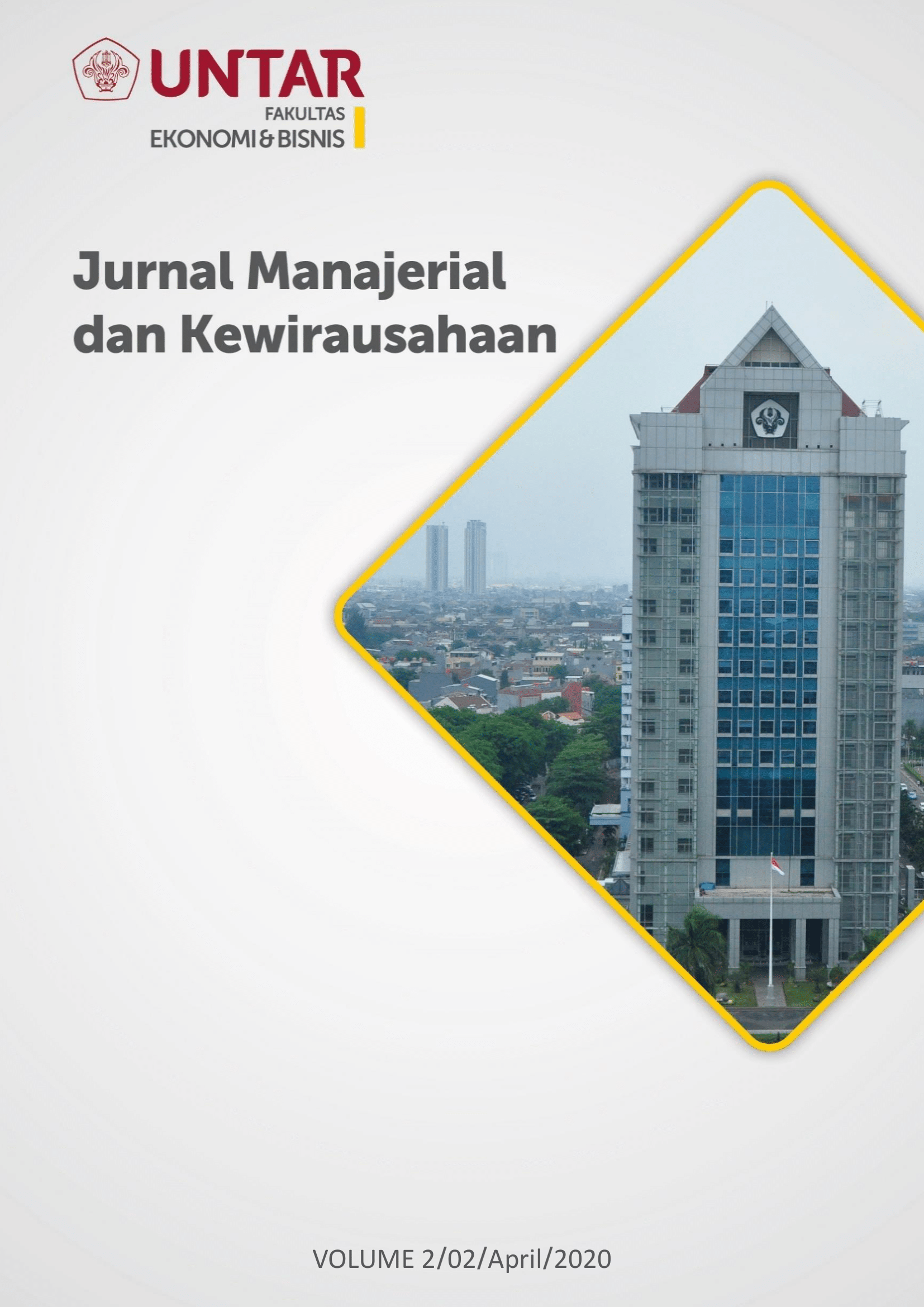Faktor Penentu Profitabilitas Pada Perusahaan Manufaktur Sektor Consumer Goods
Main Article Content
Abstract
The purpose of this study is to examine the effect of debt to total assets ratio, current ratio, efficiency, and corporate growth on profitability on manufacturing companies in the sector of consumer goods listed in Indonesia Stock Exchange in the period 2015-2018. Number of samples are 36 samples by purposive sampling method. Data were collected through Indonesia Stock Exchange official website, which are idx.co.id and idnfinancials.com. Data were processed by using Eviews10 software. The results in this study show that debt to total assets ratio has a positive significant effect on profitability (ROE). Efficiency (TATO) has a negative significant effect on profitability (ROE). While current ratio and corporate growth (asset growth) have no significant effect on profitability (ROE).
The purpose of this study is to examine the effect of debt to total assets ratio, current ratio, efficiency, and corporate growth on profitability on manufacturing companies in the sector of consumer goods listed in Indonesia Stock Exchange in the period 2015-2018. Number of samples are 36 samples by purposive sampling method. Data were collected through Indonesia Stock Exchange official website, which are idx.co.id and idnfinancials.com. Data were processed by using Eviews10 software. The results in this study show that debt to total assets ratio has a positive significant effect on profitability (ROE). Efficiency (TATO) has a negative significant effect on profitability (ROE). While current ratio and corporate growth (asset growth) have no significant effect on profitability (ROE).
Article Details
This work is licensed under a Jurnal Muara Ilmu Ekonomi dan Bisnis Creative Commons Attribution-ShareAlike 4.0 International License.,/p>
References
Alarussi, A. S. & Alhaderi, S. M. (2017). Factors Affecting Profitability in Malaysia. Journal of Economics Studies, 45(3), 442-458.
BEI. (2019). Bursa Efek Indonesia. Retrieved November, from www.idx.co.id.
Bhayani, S. J. (2010). Determinant of Profitability in Indian Cement Industry: An Economic Analysis. South Asian Journal of Management, 17(4), 6.
Chadha, S. & Sharma, A. K. (2015). Capital Structure and Firm Performance: Empirical Evidence from India. SAGE Publications, 19(4), 295-302.
Ezirim, C. B., Eniekezimene, D., Ali, O. U., & Elike, U. (2018). Company-Specific Correlates of Corporate Profitability: Evidence from Quoted Insurance Companies in Nigeria. African Journal of Business and Economic Research (AJBER), 13(1), 81-113.
Hanifah, O. E. & Purwanto, A. (2013). Pengaruh Struktur Corporate Governance dan Financial Indicators Terhadap Kondisi Financial Distress. Diponegoro Journal of Accounting, 2(2), 1.
Hidayat, F. (2019). Tiga Tantangan Utama Industri FMCG di Indonesia. Retrieved October 25, 2019, from https://www.beritasatu.com/ekonomi/536112/tiga-tantanganutama-industri-fmcg-di-indonesia.
IDN Financials (2019). IDN Financials. Retrieved November, from www.idnfinancials.com.
Janjua, A. R., Asghar, A., Munir, U., Raza, A., Akhtar, N., & Shahzad, K. Influence of Liquidity on Profitability of Cement Sector: Indication from Firms Listed in Pakistan Stock Exchange. Business Management Dynamics, 6(5), 01-12.
Latha, M. & Rao, S. N. (2017). Determinants of Profitability: Evidence from Listed Companies in the BSE-FMCG. International Journal of Economic Perspectives, 11(3), 1264-1272.
Leventis, S., Dimitropoulos, P. E., & Anandarajan, A. (2012). Signalling by Banks Using Loan Loss Provisions: The Case of The European Union. Journal of Economic Studies, 39(5), 604-618.
Liargovas. P. G. & Skandalis, K. S. (2010). Factors Affecting Firms’ Performance: The Case of Greece. Global Business and Management Research: An International Journal, 2(2&3), 184-197.
Mavlanova, T. (2012). Signaling Theory and Information Asymmetry in Online Commerce from the Seller and Buyer Perspectives. Disertasi. The City University of New York.
Migliardo, C. & Schiliro, D. (2016). Mid-Sized Italian Manufacturing Firms: A Panel Data Analysis on Profitability. Journal of Advanced Studies in Finance, 2(14), 129-145.
Nanda, S. & Panda, A. K. (2017). The Determinants of Corporate Profitability: An Investigation of Indian Manufacturing Firms. International Journal of Emerging Markets, 13(1), 66-86.
Olarewaju, O., Oladejo, T., Olaoye, C., Olarewaju, O., & Ogunmakin, A. (2018). Firm Specific Determinants of Profitability in the Insurance Sector: Empirical Evidence from Nigeria. Euro Economica, 1(37), 95-107.
Pervan, M. & Mlikota, M. (2013). What Determines The Profitability of Companies: Case of Croatian Food and Beverage Industry. Ekonomska Istrazivanja-Economic Research, 26(1), 277-286.
Priyanto, S. & Darmawan, A. (2017). Pengaruh Debt to Asset Ratio (DAR), Debt to Equity Ratio (DER), Long Term to Asset Ratio (LDAR) dan Long Term to Equity Ratio (LDER) Terhadap Profitability (ROE) Pada Perusahaan Manufaktur di Bursa Efek Indonesia Periode 2012-2014. Jurnal Manajemen dan Bisnis Media Ekonomi, 17(1), 25-32.
Rahmawati, A. N. (2010). Pengaruh Konservatisme Akuntansi, Asset Growth dan Ukuran Perusahaan Terhadap Profitabilitas Masa Depan Perusahaan. Skripsi. Universitas Sebelas Maret Surakarta.
Sari, P. R. P. & Dwirandra, A. A. N. B. (2019). Pengaruh Current Ratio dan Debt to Equity Ratio Terhadap Profitabilitas Dengan Intellectual Capital Sebagai Pemoderasi. EJurnal Akuntansi Universitas Udayana, 26(2), 851-880.
Waleed, A., Pasha, A. T., & Akhtar, A. (2016). Exploring The Impact of Liquidity on Profitability: Evidence from Banking Sector of Pakistan. Journal of Internet Banking and Commerce, 21(3).



